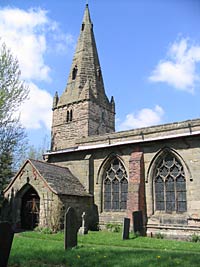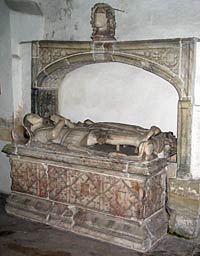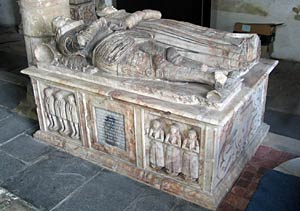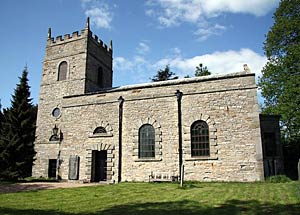< Previous | Contents | Next >
Four Stone Knights and their Ladies
RATCLIFFE-ON-SOAR. A lane winding with the river brings us to its neat cottages with hooded windows, and a brook flows under the road which ends at the church and the old manor house, now a farm. The churchyard is filled with the murmur of running water, and from a great ash tree we catch a glimpse of the river leaping the weir, and of Red Hill where it falls into the Trent.

Ratcliffe-on-Soar church in 2006.
It has a church in Domesday Book, but much of the church we see is 13th century. Its glory is in splendid tombs, in bright light streaming through medieval windows, and in the feeling of simplicity and age which restoration has not disturbed. Time seems to have stood still within these grey walls.
The tower is from the end of the 12th century, and the 13th century spire springs from a corbel table with corner pinnacles which are miniatures of the spire itself. The spacious chancel is remarkable for being longer than the nave; some of its walling and part of the south aisle is also 13th century. From the 14th come the porch with its old roof timbers, the doorway and the lovely windows of the south aisle, the arch and east window of the chancel, and the nave arcades. The chancel has its old sedilia and piscina and a founder's recess. The 600-year-old font bowl has a cover of about 1660. The medieval stone altar is still in use, and there is an unused Jacobean altar table. The altar rails are 17th century, and splendid old beams are left in the nave and chancel roofs.

Tomb of Ralph and Cecilia Sacherevell (1539).
The battered but still magnificent tombs of the Sacheverells are remarkable for the beauty of their detail. They are of four generations, and bring to an end the Ratcliffe branch of this famous family. On a handsome tomb with an elaborate canopy lies Ralph Sacheverell of 1539 and his first wife Cecilia, he in plate armour and SS collar, his head on a helmet and his feet on a lion; she wearing a cape, a lovely headdress, and round her neck a triple chain with a cross. On a splendid tomb between the chancel and the chapel, with figures of their 17 children, Sir Henry Sacheverell of 1558 lies with his wife, who wears a close-fitting gown with puffed sleeves, a cap, and a triple chain. Henry has tiny ruffs with his plate armour, and a double chain with a cross. His bearded head rests on a helmet with the crest of a goat, and his gauntlets are at his side.

Chest tomb of Henry and Jane Sacheverell (1625).
Under the adjoining arch lies the next Henry Sacheverell with his wife, both in ruffs, with their six children carved on the side of the tomb. Henry's head is on a helmet and his gauntlets are at his feet; and his lady has a bit of lovely lace at the top of her gown. We see the last of them, Henry Sacheverell of 1625, lying in armour on the tomb of a monument in the chancel. Under the canopy above him kneel his three wives, their dress showing how fashion changed in the early part of the 17th century. On a panel are a son and two daughters. One of the daughters was grandmother of little Anne Columbell, who died when she was 15; her floorstone is in the chancel. A stone with the portrait of a priest of 1497 perhaps belongs to John Prescott; another shows Isabel, the wife of Sir John Babington.
St Peter in the Rushes
REMPSTONE. It lies at the end of a lovely road from Hathern, where we have magnificent views of the widespread countryside. Its name is its distinction, for here lived generations of the Rempstones, and here was born that Sir Thomas who helped to put Henry the Fourth on the throne; he lives in Shakespeare, and sleeps with his soldier son in the church at Bingham.

Rempstone church in 2009.
© Copyright Richard Croft and licensed for reuse under this Creative Commons Licence
The plain but neat little church has a gallery adorned with carved panels, a beautiful peace memorial of bronze and alabaster, and a richly engraved brass plate in the floor to the Davys family; on it is mentioned George Davys, the Bishop of Peterborough who was tutor to Queen Victoria. The church was built in 1771, much of the material coming from the ancient church which stood in the fields not far from the white-walled hall. Known as St Peter in the Rushes, the site of the lost church is marked by a number of old gravestones and the railed-in tomb of Robert Marsden, who was rector here for 46 years of the 18th century. His charity still keeps his memory green.
